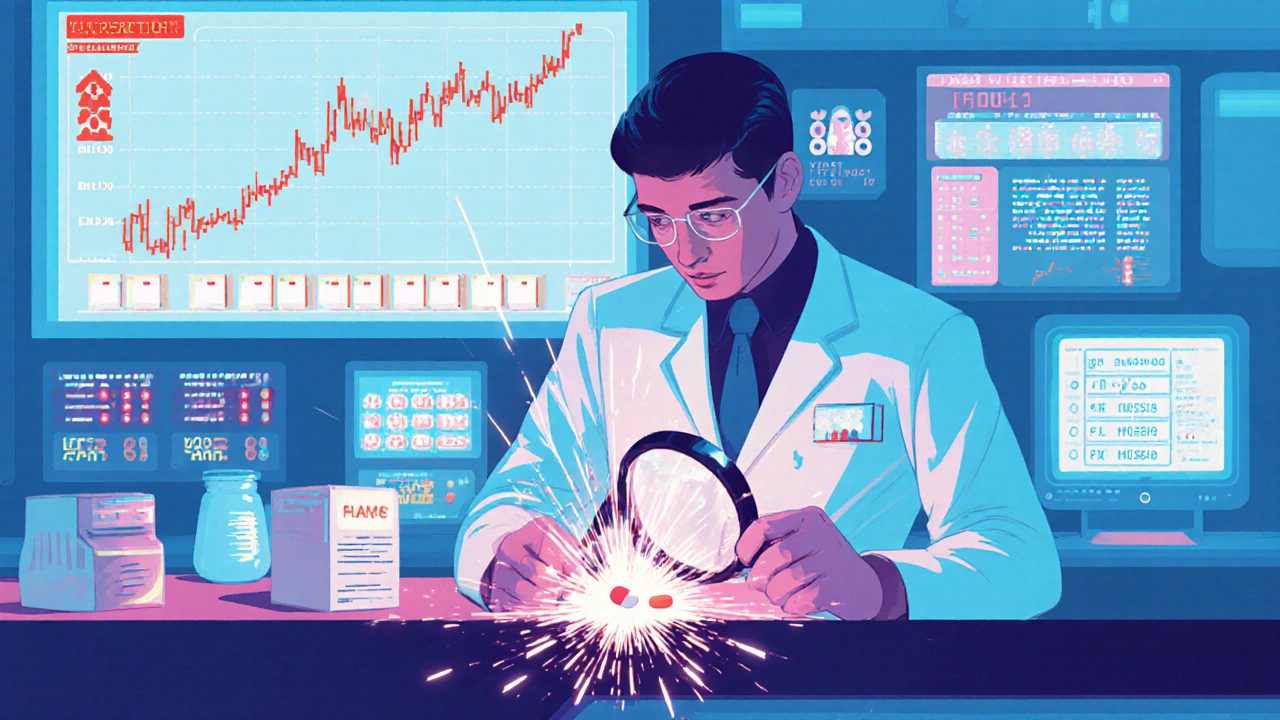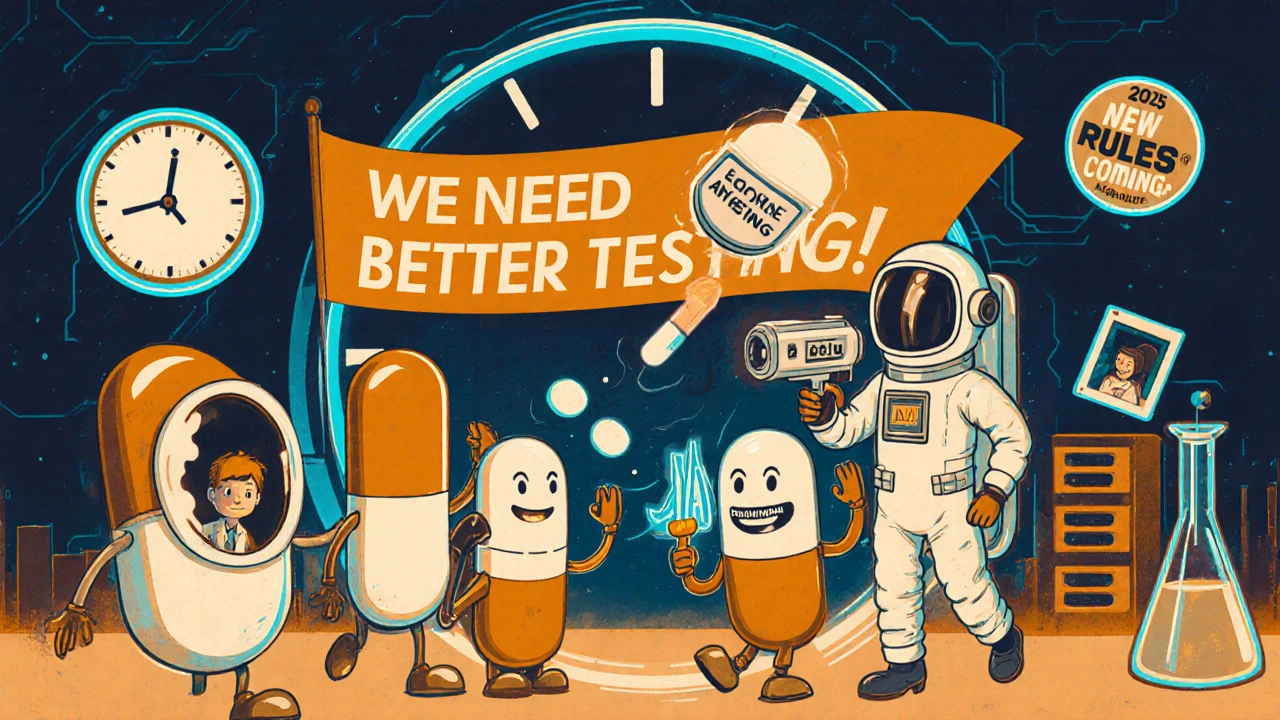When you pick up a generic pill at the pharmacy, you expect it to work just like the brand-name version. But how does the FDA make sure it’s safe after it’s on the shelf? Unlike brand-name drugs, which go through years of clinical trials before approval, generic drugs are approved based on one key fact: they’re bioequivalent to the original. That means they deliver the same active ingredient at the same rate and amount. But bioequivalence doesn’t guarantee every batch will perform the same in real life. That’s where post-approval surveillance comes in - and it’s far more complex than most people realize.
What Happens After a Generic Drug Gets Approved?
The FDA doesn’t just approve a generic drug and walk away. Once it hits the market, the real work begins. The Center for Drug Evaluation and Research’s Office of Generic Drugs (OGD) runs a dedicated team called the Clinical Safety Surveillance Staff (CSSS). This group of doctors, chemists, and data analysts tracks about 1.2 million adverse event reports every year. These reports come from doctors, pharmacists, patients, and manufacturers through systems like MedWatch and the Drug Quality Reporting System (DQRS). The key difference between brand and generic drug monitoring? Brand drugs are watched for side effects tied to the active ingredient. Generic drugs are watched for problems tied to the product itself - things like a tablet that doesn’t dissolve, a patch that falls off, or a liquid that forms clumps. These aren’t about the medicine’s chemistry. They’re about manufacturing.How the FDA Finds Problems in Real Time
The FDA doesn’t wait for complaints to pile up. They use two main methods: retrospective analysis and prospective monitoring. Retrospective analysis looks backward. Every month, CSSS pulls data from DQRS - the system that collects about 50,000 quality complaints annually. They sort these by manufacturer, lot number, and defect type using custom SAS software. If one company’s version of metformin has 70% of the complaints but only 30% of the market share, that’s a red flag. It means something’s wrong with their product, not just random bad luck. Prospective monitoring looks forward. The FDA keeps a “Newly Approved Generic Watch List.” Any generic drug approved in the last 6 to 12 months gets extra scrutiny. Why? Because of the Weber Effect. When a new generic hits the market, doctors and patients notice it more. They report problems - even minor ones - that might have been ignored before. This can make it look like there’s a spike in safety issues, but it’s often just increased attention. The FDA knows this and uses it to catch real problems early.What Kinds of Problems Are Reported?
Most complaints aren’t about side effects like dizziness or nausea. They’re about physical failures:- 17% of quality complaints involve tablets that don’t dissolve properly
- 12% involve liquid medications forming precipitates or clumps
- 9% involve patches that fall off too soon

Who Reports These Problems?
Healthcare professionals file about 68% of the reports. Pharmacists alone make up 42% of those submissions. That’s because they’re the ones filling prescriptions, seeing patients’ reactions, and noticing when a new batch behaves differently. Patients file the rest. But here’s the problem: only 28% of patients who report an issue feel like they ever got a response. The FDA doesn’t have the staff to personally reply to every complaint. That’s why they focus on patterns - not individual stories. If one person says their pill tastes weird, it’s noise. If 50 people say the same thing about the same lot number, it’s a signal.The Hidden Gap: Therapeutic Inequivalence
The biggest criticism of the system isn’t about manufacturing defects. It’s about therapeutic inequivalence - when a generic drug doesn’t work as well as the brand, even if it’s technically bioequivalent. Dr. Robert Temple, former FDA deputy director, admitted the system is “excellent for detecting quality defects but less sensitive to subtle efficacy differences.” This matters most for drugs with a narrow therapeutic index - where the difference between a safe dose and a toxic one is tiny. Think levothyroxine, warfarin, or seizure medications. In 2019, hundreds of patients reported inconsistent effects from generic levothyroxine. The FDA received 217 MedWatch reports. It took 18 months to investigate. Why? Because the system isn’t built to test for small changes in how the body absorbs the drug. Bioequivalence is measured in one lab, under controlled conditions. Real bodies in real life? That’s a different story. A 2021 Government Accountability Office report found that only 65% of potential therapeutic inequivalence signals were fully investigated - mostly because of limited resources.How the FDA Decides What to Do
When a signal is found, it goes to the OGD Clinical Safety and Surveillance Committee. This group meets every month. It includes experts from safety, manufacturing quality, and epidemiology. They review everything: complaint trends, market share, lab results, and patient outcomes. If they find a serious, widespread issue, they can trigger a Health Hazard Evaluation (HHE). These evaluations rate two things: how likely the problem is to happen, and how severe it would be. Based on that, the FDA can ask the company to recall the product, change the labeling, or even halt production. About 120 to 150 HHEs are done each year. Most result in voluntary corrections from manufacturers. The Generic Pharmaceutical Association says 90% of signals are resolved this way.
What’s Changing in 2025?
The system isn’t static. New tools are being added:- In 2023, the FDA started using AI to analyze reports. It cut false positives by 27%.
- By Q3 2024, they plan to integrate real-time pharmacy claims data - so they can see how often a drug is prescribed and how often problems are reported, side by side.
- A proposed rule in Q2 2025 could require mandatory post-approval bioequivalence testing for narrow therapeutic index drugs.
- A patient-facing portal for reporting therapeutic issues is in beta testing as of early 2025.
What You Can Do
If you notice your generic medication isn’t working the same way - whether it’s side effects, lack of effect, or physical problems like pills that won’t dissolve - report it. Go to MedWatch and file a report. You don’t need a doctor’s note. You don’t need proof. Just describe what happened. If you’re a pharmacist or prescriber, document changes. Note the manufacturer and lot number. That data is gold for the FDA. The system works best when people speak up. It’s not perfect. It’s not fast. But it’s the only thing standing between a bad batch and a patient who doesn’t get the medicine they need.Why This Matters
Generic drugs save the U.S. healthcare system billions every year. But their safety relies on a quiet, behind-the-scenes network of data, analysis, and human judgment. The FDA doesn’t test every pill. It watches for patterns. It listens to pharmacists. It tracks lots. It uses AI. It adapts. The goal isn’t to catch every single problem. It’s to catch the ones that matter - before they hurt someone.Does the FDA test generic drugs after they’re approved?
The FDA doesn’t test every batch of generic drugs after approval. Instead, they rely on post-market surveillance - collecting and analyzing reports of problems from patients, pharmacists, and manufacturers. They look for patterns across lots and manufacturers to identify potential safety issues. Routine testing of every batch isn’t feasible or required by law for generics.
Are generic drugs less safe than brand-name drugs?
No, generic drugs are not inherently less safe. They must meet the same strict standards for quality, purity, and strength as brand-name drugs. The FDA’s post-approval surveillance system is designed to catch any issues that arise after a generic enters the market - whether it’s a manufacturing flaw or a delivery problem. Most safety issues are isolated to a single manufacturer’s batch, not the drug itself.
Why do some people say their generic medicine doesn’t work like the brand?
Some patients report differences in how a generic drug works - like faster onset, shorter duration, or different side effects. This can happen with drugs that have a narrow therapeutic index, where tiny changes in absorption matter. While generics must be bioequivalent, real-world factors like stomach pH, food intake, or even the inactive ingredients can affect how the body handles the drug. The FDA is working on new rules to require post-approval testing for these high-risk drugs starting in 2025.
How long does it take the FDA to act on a safety report?
There’s no fixed timeline. Simple issues, like a labeling error, can be fixed in days. Complex signals - like a pattern of tablet disintegration across multiple lots - can take months to investigate. The FDA prioritizes based on severity and scale. For example, if a drug is linked to hospitalizations, action happens faster. For less urgent issues, it can take 6-9 months to confirm a trend and respond.
Can I trust a generic drug if it’s much cheaper?
Yes. Price differences reflect manufacturing costs, not quality. The FDA requires all generics to prove they’re equivalent to the brand before approval. The lower price comes from not having to repeat expensive clinical trials. The FDA’s surveillance system helps ensure that even low-cost generics remain safe. If a generic is significantly cheaper and you’re concerned, check the manufacturer - some are known for consistent quality, while others have had recalls in the past.
What’s the biggest weakness in the FDA’s generic drug safety system?
The biggest weakness is detecting therapeutic inequivalence - when a generic drug works differently in the body, even if it’s technically bioequivalent. The current system is excellent at catching manufacturing defects but struggles to identify subtle differences in how the drug is absorbed or released over time. This is especially concerning for drugs like thyroid medication, blood thinners, and epilepsy treatments. The FDA is addressing this with new proposed rules requiring post-approval testing for these high-risk drugs.

